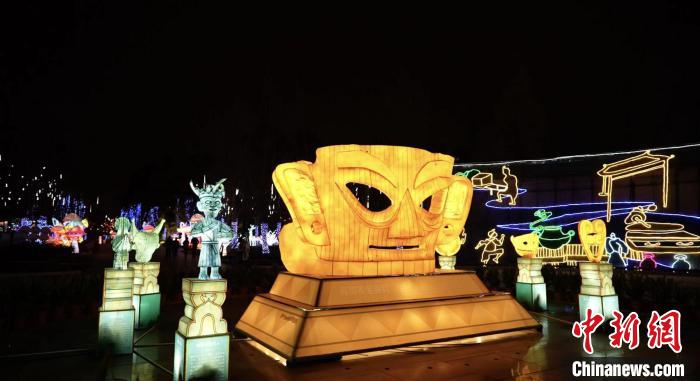Museums enrich Spring Festival’s celebrations across China
From:People's Daily OnlineAuthor: 2023-01-31 17:10

Photo shows Jinsha Site Museum in Chengdu, southwest China’s Sichuan Province. (Chinanews.com/Photo provided by Jinsha Site Museum)
Visiting museums has emerged as a new way of celebrating the Chinese New Year, or Spring Festival, in addition to going to cinemas, exchanging digital red envelopes, traveling and enjoying winter sports.
Many museums across China have hosted exhibitions and special events to usher in the Year of the Rabbit, ranging from a rabbit-themed photo exhibition jointly curated by 52 museums to special New Year exhibitions held by Shanghai Museum and Yangzhou Museum, providing a cultural feast for visitors.
Multiple museums have focused on rabbit-related culture to welcome the new year.
Sichuan Museum staged an exhibition displaying rabbit-themed cultural relics, attracting crowds of visitors. The exhibition not only showed themed cultural relics but also set up five interaction zones for children to learn more about Chinese Zodiac culture through fun activities.
“Seeing those adorable bunnies on cultural relics seems to take away all your worries,” said Yan Yujin from Chengdu, southwest China’s Sichuan Province, during his visit to Sichuan Museum. Yan got an immersive experience of the life aesthetics from the Song Dynasty (960-1279) as well as its interaction with modern trends at the museum, which is a New Year gift he brought to himself.

Photo shows a rabbit-themed cultural relic exhibition at Sichuan Museum in Chengdu, southwest China’s Sichuan Province. (Photo/An Yuan)
According to Wei Ziqi, a staff member from Sichuan Museum, the museum tailored a cartoon rabbit image for the exhibition, so as to bring tourists closer to the museum.
Guochao, a fashion trend translated as “China-chic”, and various technologies have gradually brought a new lease of life to relics that had been languishing behind windows, Wei noted.
Though Spring Festival customs evolve and change, the festive atmosphere remains the same.
Despite the cold weather, a scene of hustle and bustle was seen at Chengdu Museum, where visitors were busy copying the character “Fu”, or “good fortune” in English, from inscriptions, making colorful lanterns and designing tops.
“Copying ‘Fu’ from inscriptions by hand can spark children’s interest in traditional Chinese culture,” said Liu Jie, who came to the museum with her child.

Visitors copy the character “Fu”, or “good fortune” in English, from inscriptions at Chengdu Museum in Chengdu, southwest China’s Sichuan Province. (Photo/Yang Yudi)
In addition to exhibiting ancient treasures and launching creative cultural products, the Jinsha Site Museum in Chengdu combines technologies with archaeology, putting on an outdoor exhibition for this year’s Spring Festival. In the exhibition, the bronze standing figure unearthed at the Jinsha site becomes a “tech geek”, sets of lanterns themed on sun worship from around the world make their appearance, and a string of lanterns stretching over 40 meters depicts how people in ancient times produced copper and gold and made jade objects.
“In the past few years, Jinsha Site Museum has been paying more attention to traditional customs during the Spring Festival, but this year we integrated Guochao elements into our exhibitions, establishing must-visit areas for Hanfu fans,” said Yao Fei, deputy curator of Jinsha Site Museum.
As China’s society and economy continue to develop, people’s needs for intellectual and cultural consumption have become more diversified and personalized.
Celebrating the Spring Festival at museums reflects the rapid development of China’s museums.

Photo shows Jinsha Site Museum in Chengdu, southwest China’s Sichuan Province. (Chinanews.com/Photo provided by Jinsha Site Museum)
According to statistics, the number of China’s registered museums rose from 4,692 to 5,788 between 2016 and 2020, entering the global top five. As of May 18, 2022, 5,605 museums across the country offered free admission, accounting for over 90 percent of the total.
Huang Xiaofeng, deputy curator of Chengdu Museum, said the popularity of museums during the Chinese New Year is closely related to current socioeconomic progress, and is also a result of museums coming closer to the trend of the times as well as people’s daily lives.
“During the Spring Festival, each museum will try its best to appeal to visitors by holding unique cultural activities, so it can be viewed as ‘drawing closer to each other’,” Huang said.
In response to people’s cultural consumption needs, the museum has made great efforts to develop creative cultural products that feature a mix of traditional festive elements and modern Guochao style.
Edit:董丽娜
The copyright of the article and the picture belongs to the original author. If there is any infringement, please contact to delete it